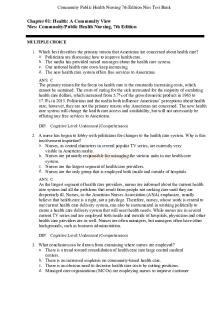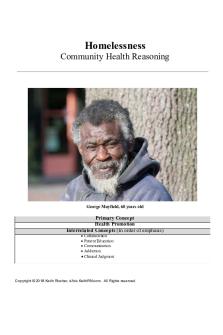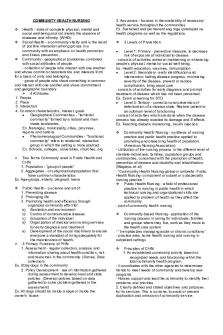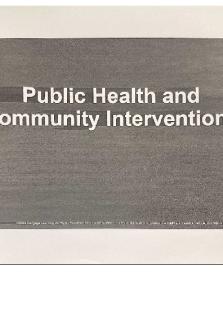Community Based Health CARE-notes PDF

| Title | Community Based Health CARE-notes |
|---|---|
| Course | Clinical medicine |
| Institution | Mount Kenya University |
| Pages | 17 |
| File Size | 158.5 KB |
| File Type | |
| Total Downloads | 104 |
| Total Views | 201 |
Summary
madam...
Description
COMMUNITY BASED HEALTH CARE (CBHC) CBHC is health care for all people of all ages who need health care assistance at home. Community care services include home support e.g. nursing care, physiotherapy and other rehabilitation services.. e.g. a nurse visits an elderly person at home to help with medication, a home support worker helps a child in a wheel chair with personal care such as bathing. Community based health care is a health care, for the community and by the community, working together to achieve health for all. It promotes self care, independence and family support networks. CBHC tries to prevent disease and promote health from inside the community rather than from outside. It means health care which the people themselves feel they need and can supply from there own resources. It’s a health care where people themselves take the responsibility for there own health i.e. at the individual, family and the community level. It does not just involve people caring for their health needs by direction from professional health workers. As compared to outreach health care, CBHC comes from within the community. Outreach health care comes to the community from outside. It does not belong to the community, although it is generally appreciated by the community but when it stops, its influence tends to subside quickly. Community based health care tackles poverty directly (head-on)/ face to face .- it does this through empowerment, and through partnership it enables communities to share their skills and resources, to each others benefits.
Special features which make CBHC different from standard medical care 1
CBHC encourages ownership by the community. -
the community participates, becomes partner and eventually owns the programme. Whereas standard medical care is provided by Doctors and health workers to the people. Therefore CBHC is a genuine partnership of health workers with the community members.
CBHC responds to the needs of the people. -
Standard medical care starts with planners, projects and governments, whereas CBHC starts with the people, helps them identify their needs, and works together with them to find answers.
CBHC leads to self- reliance. -
Standard medical care often introduces two unwanted side effects; a dependence on medicine and dependence on doctors. CBHC aims to bring about healthy, self reliant communities- through this people become armed with knowledge so they depend less on outsiders.
CBHC helps to encourage community life. -
In CBHC traditional practices are encouraged unless they are proved to be harmful, new ideas are introduced with a lot of sensitivity. In CBHC the aim of the health worker is always to build up confidence and dignity and never to cause offence or humiliation.
CBHC moves to where the people live.
2
-
In CBHC care is based in the community (whenever possible), and not the clinic or hospital. It is decided according to the needs of the community, rather than the convenience of the doctor or the health worker. Sick people are treated at their homes or as near to their homes as possible\
CBHC moves forward to the next generation. Children become a focal point of health activities. They are not simply targeted for improved health care but are involved in bringing it out. -
Healthy patterns of living absorbed by children today, become the accepted practices of tomorrow.
CBHC helps to bring about behavioural change. -
Through the excitement of discovering new ideas and different practices, real changes in lifestyles start to occur and health begins to improve.
CBHC includes all in the community. -
The poorest, the most in need, and the most at risk are given priority. Women are given equal status. The elderly and the handicapped are cared for.
CBHC depends on co-operation and integration. -
Without losing their unique strengths and values, community health programmes try to integrate into the health services of the country. Whenever possible other doctors, practitioners and development workers are consulted and included. Other voluntary programmes are welcomed and ideas mutually shared.
3
CBHC aims for a new community order. -
As community takes initiatives, as health standards improve and as other forms of development emerge, a new order starts to take shape. And this is based on: Justice. Where the rich are no longer allowed to exploit the poor, nor the strong allowed to oppress the weak. Equity. Where all have sufficient, and the differences between the rich and the poor are reduced. Unity. Where individuals and community groups learn mutual respect and whereby working towards a common goal, they overcome tribal, ethnic and other differences.
Community Based Health Care emphasizes on health in the following ways: CBHC is involved more in health care than in medical care. It opposes the use of drugs for every health problem. Instead it emphasizes that well-being is largely brought about through healthy living patterns and enlightened attitudes. CBHC emphasizes appropriate cure. Most health workers use too many medicines and injections many of which are unnecessary and others even harmful. Community Based Health Care tries to ensure that a rational list of essential, life-saving drugs are always available, affordable and appropriately used. CBHC follows a comprehensive and integrated model of health care, and aims to include the following:
Health education.
Mother and child health services
4
Diagnostic and curative care,
Control of infectious diseases,
Adequate nutrition,
Immunization.
Improvement in water supply and sanitation,
Referral systems,
Monitoring and evaluation and
Effective management.
CBHC is not -
Opposed to doctors and hospitals. It clearly recognizes that both doctors and hospitals have a vital role to play in health care.
-
Adding new structures onto old foundations. CBHC is not an extension of a hospital into a village clinic, it is rather a complete restructuring of health care system so that the people become partners with health care providers.
-
A second rate health service for the poor, as long as it is correctly set up and adequately supervised.
COMMUNITY DIAGNOSIS Just as patients are questioned and examined in order to make a diagnosis, the same is done to a community. In this way we can discover it main health problems, their underlying causes and explore possible solutions with community members.
Sources of information which are needed to make community diagnosis
5
1. The rapid appraisal which provides descriptive or qualitative information. 2. The community survey which gives numerical, quantitative or ‘hard data’ about the health of the community. Further information may be obtained from previous reports and hospital or clinic records. What is done: Tally the results (add up). These are then added to give the total for the community. (see the figure a) The totals from the tally are then tabulated out on to a community diagnosis form (see figure b) Example: For each community we will need to know the total number of malnourished children under five years, (this will be the numerator (N) or the actual number). We will also want to know the total number of children under five (both malnourished and wellnourished together). This will be the denominator (D) or eligible number. Percentages(% s) convey the most useful information. They give a picture of how serious a problem is at any one time. By comparing percentages over a period of time we are able to tell how much improvement has occurred. Figures for students to see: tally sheet, community diagnosis form, 5 main causes of death in the community, prioritizing or ranking problems. List problems : This involves drawing up a list of serious problems for each community surveyed. The community diagnosis form contains spaces both for figures from the tally, and written observations from the surveyor. Both are taken into account when drawing up the problem list. Prioritizing or ranking problems. (students to see table 6.1).
6
Health promotion The Ottawa Chatter for Health Promotion The Charter This was the first International Conference on Health Promotion, meeting in Ottawa this 21st day of November 1986. During this conference a charter was presented. The CHARTER is for action to achieve Health for All by the year 2000 and beyond. This conference was primarily a response to growing expectations for a new public health movement around the world. Discussions focused on the needs in industrialized countries, but took into account similar concerns in all other regions. It built on the progress made through the Declaration on Primary Health Care at Alma Ata, the World Health Organization’s Targets for Health for All document, and the recent debate at the World Health Assembly on inter-sectoral action for health. HEALTH PROMOTION Health promotion is the process of enabling people to increase control over, and to improve, their health. To reach a state of complete physical, mental and social well-being, an individual or group must be able to identify and to realize aspirations, to satisfy needs, and to change or cope with the environment. Health is therefore, seen as a resource for everyday life, not the objective of living. Health is a positive concept emphasizing social and personal resources, as well as physical capacities. Therefore, health promotion is not just the responsibility of the health sector, but goes beyond healthy life-styles to well-being. PREREQUISITES FOR HEALTH The fundamental conditions and resources for health are peace, shelter, education, food, income, a stable eco-system, sustainable resources, social justice and equity. Improvement in 7
health requires a secure foundation in these basic prerequisites. To arrive at these prerequisites there is need to: ADVOCATE Good health is a major resource for social, economic and personal development and important dimension of quality of life. Political, economic, social cultural, environmental, behavioural and biological factors can all favour health or be harmful to it. Health promotion action aims at making these conditions favourable through advocacy for health. ENABLE Health promotion focuses on achieving equity in health. Health promotion action aims at reducing differences in current health status and ensuring equal opportunities and resources to enable all people to achieve their fullest health potential. This includes a secure foundation in a supportive environment, access to information, life skills and opportunities for making healthy choices. People cannot achieve their fullest health potential unless they are able to take control of those things which determine their health. This must apply equally to women and men. MEDIATE The prerequisites and prospects for health cannot be ensured by the health sector alone. More importantly, health promotion demands coordinated action by all concerned: by governments, by health and other social and economic sectors, by non-governmental and voluntary organizations, by local authorities, by industry and by the media. People in all walks of life are involved as individuals, families and communities. Professional and social groups and health personnel have a major responsibility to mediate between differing interests in society for the pursuit of health. Health promotion strategies and programmes should be adapted to the local needs and possibilities of individual countries and regions to take into account differing social, cultural and
8
economic systems. HEALTH PROMOTION ACTION MEANS: BUILD HEALTHY PUBLIC POLICY Health promotion goes beyond health care. It puts health on the agenda of policy makers in all sectors and at all levels, directing them to be aware of the health consequences of their decisions and to accept their responsibilities for health. Health promotion policy combines diverse but complementary approaches including legislation, fiscal measures, taxation and organizational change. It is coordinated action that leads to health, income and social policies that foster greater equity. Joint action contributes to ensuring safer and healthier goods and services, healthier public services, and cleaner, more enjoyable environments. Health promotion policy requires the identification of obstacles to the adoption of healthy public policies in non-health sectors, and ways of removing them. The aim must be to make the healthier choice the easier choice for policy makers as well. CREATE SUPPORTIVE ENVIRONMENTS Our societies are complex and interrelated. Health cannot be separated from other goals. The inextricable links between people and their environment constitutes the basis for a socioecological approach to health. The overall guiding principle for the world, nations, regions and communities alike, is the need to encourage reciprocal maintenance – to take care of each other, our communities and our natural environment. The conservation of natural resources throughout the world should be emphasized as a global responsibility. Changing patterns of life, work and leisure have a significant impact on health. Work and leisure should be a source of health for people. The way society organizes work should help create a
9
healthy society. Health promotion generates living and working conditions that are safe, stimulating, satisfying and enjoyable. Systematic assessment of the health impact of a rapidly changing environment – particularly in areas of technology, work, energy production and urbanization – is essential and must be followed by action to ensure positive benefit to the health of the public. The protection of the natural and built environments and the conservation of natural resources must be addressed in any health promotion strategy. STRENGTHEN COMMUNITY ACTION Health promotion works through concrete and effective community action in setting priorities, making decisions, planning strategies and implementing them to achieve better health. At the heart of this process is the empowerment of communities, their ownership and control of their own endeavours and destinies. Community development draws on existing human and material resources in the community to enhance self-help and social support, and to develop flexible systems for strengthening public participation and direction of health matters. This requires full and continuous access to information, learning opportunities for health, as well as funding support. DEVELOP PERSONAL SKILLS Health promotion supports personal and social development through providing information, education for health and enhancing life skills. By so doing, it increases the options available to people to exercise more control over their own health and over their environments, and to make choices conducive to health. Enabling people to learn throughout life, to prepare themselves for all of its stages and to cope with chronic illness and injuries is essential. This has to be facilitated in school, home, work and
10
community settings. Action is required through educational, professional, commercial and voluntary bodies, and within the institutions themselves. REORIENT HEALTH SERVICES The responsibility for health promotion in health services is shared among individuals, community groups, health professionals, health service institutions and governments. They must work together towards a health care system which contributes to the pursuit of health. The role of the health sector must move increasingly in a health promotion direction, beyond its responsibility for providing clinical and curative services. Health services need to embrace an expanded mandate which is sensitive and respects cultural needs. This mandate should support the needs of individual and communities for a healthier life, and open channels between the health sector and broader social, political, economic and physical environmental components. Reorienting health services also requires stronger attention to health research as well as changes in professional education and training. This must lead to a change of attitude and organization of health services, which refocuses on the total needs of the individual as a whole person. MOVING INTO THE FUTURE Health is created and lived by people within the settings of their everyday life; where they learn, work, play and love. Health is created by caring for oneself and others, by being able to take decisions and have control over one’s life circumstances, and by ensuring that the society one lives in creates conditions that allow the attainment of health by all its members. Caring, holism and ecology are essential issues in developing strategies for health promotion. Therefore, those involved should take as a guiding principle that, in each phase of planning, implementation and evaluation of health promotion activities, women and men should become
11
equal partners. COMITMENT TO HEALTH PROMOTION The participants in this conference pledge: -To move into the arena of healthy public policy, and to advocate a clear political commitment to health and equity in all sectors; -To counteract the pressures towards harmful products, resource depletion, unhealthy living conditions, and environments, and bad nutrition; and to focus attention on public health issues such as pollution, occupational hazards, housing and settlements; -To respond to the health gap within and between societies, and to tackle the inequities in health produced by the rules and practices of these societies -To acknowledge people as the main health resource; to support and enable them to keep themselves, their families and friends healthy through financial and other means, and to accept the community as the essential voice in matters of its health, living conditions and well-being; -To reorient health services and their resources towards the promotion of health; share power with other sectors, other disciplines and most importantly with people themselves; -To recognize health and its maintenance as a major social investment and challenge; and to address the overall ecological issue of our ways of living. The conference urges all concerned to join them in their commitment to a strong public health alliance. CALL FOR INTERNATIONAL ACTION The conference calls on the World Health Organization and other international organizations to advocate the promotion of health in all appropriate forums and to support countries insetting up
12
strategies and programmes for health promotion. The Conference is firmly convinced that if people in all walks of life, nongovernmental and voluntary organizations, governments, the World Health Organization and all other bodies concerned join forces in introducing strategies for health promotion, in line with the moral and social values that form the basis of this CHARTER, Health for All by the year 2000 will become a reality. This CHARTER for action was developed and adopted by an international conference, jointly organized by the World Health Organization, Health and Welfare Canada and the Canadian Public Health Association. Two hundred and twelve participants from 38 countries met from November 17 to 21, 1986, in Ottawa, Canada to exchange experiences and share knowledge of health promotion. The Conference stimulated an open dialogue among lay, health and other professional workers, among representatives of governmental, voluntary and community organizations, and among politicians, administrators, academics and practitioners. Participants coordinated their efforts and came to a clearer definition of the major challenges ahead. They strengthene...
Similar Free PDFs

Community Based Health CARE-notes
- 17 Pages

Community Based ORG
- 65 Pages

Community health final
- 14 Pages

Community Health Nursing RLE
- 15 Pages

Community Health Diagnosis
- 136 Pages

ATI Community Health Focus
- 24 Pages

ATI Community Health Study
- 22 Pages

Community Health Nursing Kaplan
- 41 Pages

Community Health Test Bank
- 10 Pages

Nurs 2014 community health
- 41 Pages

COMMUNITY HEALTH NURSING NOTES
- 2 Pages
Popular Institutions
- Tinajero National High School - Annex
- Politeknik Caltex Riau
- Yokohama City University
- SGT University
- University of Al-Qadisiyah
- Divine Word College of Vigan
- Techniek College Rotterdam
- Universidade de Santiago
- Universiti Teknologi MARA Cawangan Johor Kampus Pasir Gudang
- Poltekkes Kemenkes Yogyakarta
- Baguio City National High School
- Colegio san marcos
- preparatoria uno
- Centro de Bachillerato Tecnológico Industrial y de Servicios No. 107
- Dalian Maritime University
- Quang Trung Secondary School
- Colegio Tecnológico en Informática
- Corporación Regional de Educación Superior
- Grupo CEDVA
- Dar Al Uloom University
- Centro de Estudios Preuniversitarios de la Universidad Nacional de Ingeniería
- 上智大学
- Aakash International School, Nuna Majara
- San Felipe Neri Catholic School
- Kang Chiao International School - New Taipei City
- Misamis Occidental National High School
- Institución Educativa Escuela Normal Juan Ladrilleros
- Kolehiyo ng Pantukan
- Batanes State College
- Instituto Continental
- Sekolah Menengah Kejuruan Kesehatan Kaltara (Tarakan)
- Colegio de La Inmaculada Concepcion - Cebu




